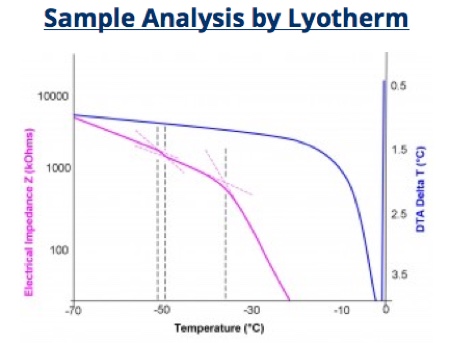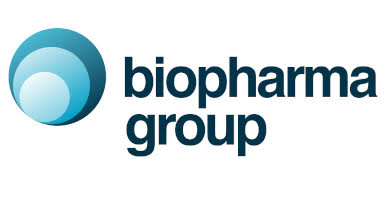Lyostat vs DSC
DSC (Differential Scanning Calorimetry) and mDSC (modulated Differential Scanning Calorimetry) are thermal techniques typically used to identify the glass transition temperature (Tg) for the purpose of stability studies in dried samples. These techniques can also be used to analyse frozen samples for the development of a safely optimised freeze-drying cycle.
Lyostat is a Freeze-Drying Microscope (FDM), which allows the user to identify and record the ‘collapse’ temperature of a sample. It also provides data on eutectic events and skin formation, showing the structure of the material as it dries at increasing temperatures in real time.
Collapse is the key temperature for freeze-drying. Collapse is defined as the point at which the solute phase of the drying formulation cannot maintain its structural integrity upon removal of the solvent, resulting in the formation of viscous flow. It occurs, more often than not, at a higher temperature than the glass transition (Tg).
Glass transition (Tg) is the reversible transition in amorphous materials from a hard and relatively brittle state into a molten or rubber-like state. Although glass transition is often considered as a pre-requisite in freeze-drying, the collapse temperature, which often occurs at significantly higher temperatures, is actually the most key critical temperature.
| Analysis | Lyostat | DSC |
| Collapse Temperature | YES | NO |
| Designed for Freeze-Drying | YES | NO |
| Eutectic Events | YES | YES |
| Skin Formation | YES | NO |
The advantages of the Lyostat:
- Lyostat is a valuable research and development tool, especially designed for freeze-drying
- Lyostat analysis uses just 2µl and is typically complete in under an hour
- Lyostat analysis is PC controlled to provide sophisticated image and data capture as well as analysis functions
- Lyostat allows the user to make a video of their sample under analysis
- The software is also available in a 21CFR11 compliant version
Why should you need a freeze-drying microscope?
- FDM analysis allows you to define the exact collapse temperature of your sample, which cannot be done with a DSC. The knowledge of a product’s collapse behaviour is vital, as a product that collapses during freeze-drying can suffer from a range of problems including reduced shelf life, reduced activity and poor reconstitution.
- Using the onset of collapse as the basis of a cycle will allow a higher temperature than using the glass transition temperature, which will mean faster drying.
- FDM allows you to observe the drying sample behaviour and to obtain data which will enable you to develop new formulations and new cycles using a systematic approach rather than trial and error.
- FDM will also enable you to scale up or optimise existing processes.
Lyotherm vs DSC
Lyotherm is a powerful tool for characterising frozen formulations. It provides more information than frozen state DSC analysis, because it performs simultaneous impedance and thermal analysis.
| Analysis | Lyotherm | DSC |
| Glass Transition Temperature (Tg) | YES | YES |
| Crystallisation Events | YES | YES |
| Eutectic Events | YES | YES |
| Softening of Material With or Without Thermal Changes | YES | NO |
| Designed for Frozen Materials and Freeze Drying | YES | NO |
The advantages of the Lyotherm:
- Lyotherm allows combined electrical impedance and differential thermal analysis (DTA) of frozen samples
- Impedance analysis reveals information about the rigidity (molecular mobility) of frozen
- DTA is a similar technique to DSC, providing thermal data at the same time as impedence analysis
- Changes in rigidity are not always associated with thermal changes so you don’t always see them in DSC or DTA analysis.
Why should you need a Lyotherm?
Comparison of Analytical Techniques
The graphs below show the frozen state analysis of amorphous material* with mDSC and Lyotherm. With the mDSC analysis no significant changes were detected. However, softening and glass transition were detected with the Lyotherm. While DSC is ideal to test dry samples, Lyotherm, which has been especially designed for freeze-drying, will provide additional data for frozen samples.

Impedance analysis shows glass transition at –50°C
Softening of the frozen material shown at –37°C preceding collapse
* An experiment was performed in Biopharma House, Winchester in 2015. A series of typical amorphous formulations were analysed using a range of techniques. The following graphs show the results for MDSC and Lyotherm for one of the formulations.
As the majority of products for freeze drying are amorphous to varying degrees, Lyotherm is indispensable to analyse products undergoing a freeze drying stage.
BTL’s Services
Over the past 15 years BTL has worked with more than 1,000 products and uses state of the art analytical equipment to characterise material before and after freeze drying. Biopharma Technology Ltd assists customers with all challenging aspects of freeze-drying as part of our Consultancy and R&D division, for example:
- Product Characterisation
- Formulation Development
- Cycle Development
- Production
- Troubleshooting
- Sell the analytical instruments Lyostat 4 and Lyotherm 2, for formulation characterisation
- We offer training courses in freeze-drying





